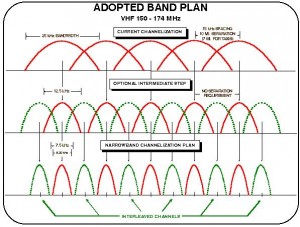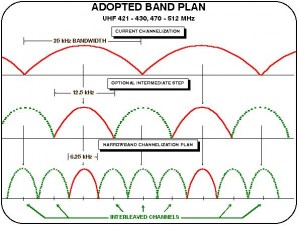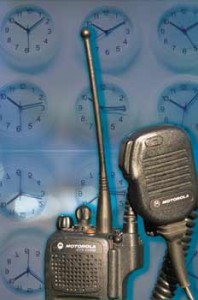730 Days & Counting
All FCC Part 90 licensees operating in VHF spectrum 150–174 MHz and UHF spectrum based on location 421–512 MHz must reduce their emission to 12.5 kHz or less or use technology that provides an equivalency to 12.5 kHz in a 25 kHz emission on or before Jan. 1, 2013.
The FCC’s ultimate goal is for 6.25 kHz or equivalent emission in the future. As of today, the FCC has not set a date for when this must take place.
I bet you’re asking why we have to do this. It boils down to a move the FCC made in 1992 known as “refarming” (PR Docket No. 92-235). In 1995, the FCC moved away from the refarming strategy, which might have required changing frequencies, but adopted rule changes to promote the transition to a more efficient narrowband channel plan. Many licensees found it difficult to find frequencies due to the large number of folks already licensed or actively looking for additional frequencies. To increase the amount of spectrum available, the FCC mandated narrowbanding and also consolidated frequencies into two pools: Public Safety and Industrial Business. Both pools must narrowband.

Figure 1: VHF Band -- Narrowbanding in VHF. Note: VHF does not use the same spacing as UHF; thus, although we are creating twice as many frequencies with a move to 12.5 kHz, it doesn’t mean we can use them -- as you’ll see in the UHF figure. (Source: FCC)
The consolidation of radio pools has already occurred and allows for the coordination of frequencies by four coordinating bodies within the public safety pool rather than requiring you to use one of four different coordinators based on the frequency you were requesting.
The radio spectrum is very congested, especially in metropolitan areas. Shifting to narrower emissions will allow frequencies to be used in between existing frequencies. With the FCC’s mild push for 6.25 kHz, new technology has been developed and adapted to the VHF and UHF spectrum that has been in use in the upper bands of 700/800 MHz. Figures 1, 2 and 3 represent narrowing emissions by simply dividing the frequency in two and then in two again.

Figure 2: UHF 421–430, 470–512 MHz -- How the intermediate step creates additional spectrum without overlap. (Source: FCC)
Meeting the Standard
I mentioned equivalencies earlier, but what does equivalency refer to? It’s an efficiency standard. For voice operations, the efficiency standard is satisfied if the equipment is capable of transmitting at least one talk path per 12.5 kHz of bandwidth. So a 25 kHz radio must be capable of supporting two or more simultaneous talk paths.
We must not ignore the data component for non-voice systems in operation. The data operations efficiency standard is satisfied as long as the equipment supports a minimum data rate of 4800 bits per second (bps) per 6.25 kHz of bandwidth. A 25 kHz frequency must operate at 19200 bps to meet the narrowband requirements.
There are exceptions to every rule. Don’t get excited, because the only exception is that paging-only channels are not subject to the mandate. Only two frequencies in the public safety pool are exempt: 152.0075 MHz and 157.450 MHz.
Key Dates
Let’s discuss time lines. I mentioned earlier that the FCC began this move in 1992. Nineteen years later, some are ready for the move, some have moved, and others are in a panic. The time line has been altered over the past several months because the FCC has accepted petitions to extend the dates of some interim deadlines.
- Jan. 1, 2011: FCC will no longer accept applications for new VHF or UHF frequencies that operate on frequencies exceeding 12.5 kHz, unless the efficiency standard is satisfied.
- Jan. 1, 2011: FCC will no longer accept applications for modifications of VHF or UHF frequencies that increase the station’s authorized footprint on frequencies exceeding 12.5 kHz, unless the efficiency standard is satisfied.
- Equipment certifications must include 6.25 kHz equivalent efficiency (can be dual mode 12.5/6.25 kHz efficiency). This does not apply to handheld transmitters with output power of 2 watts or less.
- Jan. 1, 2011:* Manufacturers are prohibited from manufacturing or importing into the U.S. any equipment capable of 25 kHz bandwidth operation that does not satisfy the efficiency standard. (No 6.25 kHz or equivalent efficiency user requirements have been set.)
- Jan. 1, 2013: All existing licensees must operate on channels with a bandwidth of 12.5 kHz or less, unless the efficiency standard is satisfied.
*Note: The FCC reiterated these dates in the 4th MO&O released on May 14, 2008. Since then, the Jan. 1, 2011, date prohibiting the manufacturing or import into the U.S. of any equipment capable of 25 kHz bandwidth operation was extended in the FCC 10-110A1 National Public Safety Telecommunications Council petition response on June 30, 2010, under a blanket waiver of Section 90.203(j)(10) until Jan. 1, 2013. However, manufacturers will still be prohibited from applying for certification for new equipment that includes a 25 kHz mode, and 6.25 kHz certification requirements begin Jan. 1, 2013, under Section 90.203(j)(5).
License Compliance
Enough tech talk and FCC quotes. Your real question is, “What do I need to do as an affected licensee?” One plan for compliance:[1]
- Verify that your agency has a current valid FCC Part 90 license, and add narrowband emissions to it.
- This is a great opportunity to make administrative updates to your license. Many of you will find that the listed contact information is for an individual who has retired, the address is incorrect or, worse, a change in technical parameters relating to the transmitter location, antenna height or transmit power has occurred.
- If you haven’t checked recently, you might find your license has expired. Operating a motor vehicle with an expired license can get you a ticket, and operating a radio with an expired license can get you fined or knocked off the air. Your frequency coordinator can help get you licensed again, but there might now be power or height restrictions to comply with. Learn more at www.apcoafc.org.
- The FCC’s Universal Licensing System (www.fcc.gov/uls) is where you’ll go to make the verifications if paper copies of the license are not available.
- Conduct a full inventory of all radios and stations in your system.
- Determine what equipment can be reprogrammed and what needs to be replaced.
- Secure your budget for services and equipment.
- Develop a wideband-to-narrowband system conversion plan that addresses:
- Replacement and installation of any narrowband-capable, off-site base or repeater station.
- The actual reprogramming of all the radios in a system as close to simultaneously as possible.
- Work closely with a professional two-way radio service vendor.
- Schedule and coordinate the actual system conversion.
- Take into account shared frequencies with your neighbors and interoperable frequencies that are currently wideband.
- Modify your FCC license to remove any wideband emission designators.
This isn’t a one-size-fits-all plan; however, it will put you in a better position to begin the process. Work with your neighboring agencies, fire associations and State Interoperable Executive Committees (SIECs). Many of these have already begun planning in some capacity.
Frequently Asked Questions
Am I required to go digital or adopt Project 25 (P25)? No, you are not required to do so. There are benefits to moving to digital; however, it is not required.
How does narrowbanding fit with rebanding? Rebanding is taking place only in the 800 MHz NPSPAC public safety pool and is being done for a different reason, and Sprint Nextel and has nothing to do with narrowbanding.
What is narrowbanding vs. broadband? They’re two separate issues. Broadband deals with the public safety block and D Block of spectrum in 700 MHz.
Will narrowbanding reduce our coverage? Without getting technical and taking you into a deep dive on signal-to-noise ratios and dB, the quick answer is that yes, it’s very possible. Narrowbanding may also affect simulcast systems. Partner with your local radio shop or vendor to verify pre and post-migration coverage.
When I narrowband, I will realize two frequencies from the migration. This is incorrect. You are reducing the emission of the current frequency; not dividing the frequency you’re using from 25 kHz into two separate 12.5 kHz frequencies.
When I narrowband, will I have to change frequencies. No. If your current frequencies are fine, you do not have to change them.
Does the FCC have a Web site that licensees can go to for information regarding narrowbanding? As of the first part of December 2010, the FCC had launched a narrowbanding Web site full of information and links to many other valuable resources: www.fcc.gov/narrowbanding.
Equipment Check
It’s critical that you work with your radio shop or vendor. Sometimes equipment is made in multiple versions, and older versions of the same model might not be capable of narrowbanding. Slightly newer versions might narrowband, but might not work on every possible narrowband channel without significant hardware or firmware revisions. Be cautious when buying used equipment “capable” of narrowband operations.
Although a complete list of compliant equipment is unavailable, the following link can help you identify narrowband-compliant radios from major suppliers: https://psc-legacy.apcointl.org/2010/01/01/narrowbanding. Even with this tool, I urge you to work with your radio shop or vendor. They can help determine any possible coverage impacts of narrowbanding.
Most radios have options to tweak the audio, called companding in narrowband operations. If you program your own equipment, check with your shop or vendor to see what impact using these settings will have. Using these settings between the same vendor’s radios may result in no noticeable effect; however, between different vendors the audio could be affected. In worst case situations, compandored audio between different brands of radios may sound distorted and actually impair communications.
When planning, don’t forget frequencies that you share with neighbors. It’s important that narrowbanding be a planned effort among all users. Communications between wideband and narrowband radios is a recipe for disaster.
Many of us have also been through 800 MHz rebanding. I myself would rather go through rebanding again — with the exception of the contract negotiations — than narrowbanding. Narrowbanding is going to require a great amount of planning to account for the logistics of addressing multiple radio programming touches; shared frequencies between disciplines and jurisdictions; the time necessary to sift through equipment inventories; and educating local officials to the necessity of budgeting for equipment reprogramming, replacement and coverage analysis — especially for the fire service, which relies heavily on tone and voice paging.
Keep in mind that your world will be much simpler after narrowbanding when it comes to shared frequencies for mutual aid that are used regionally or statewide. If your agency is part of a Tactical Interoperable Communications Plan (TICP), this will be a huge step in helping you identify frequencies, equipment, agencies and migration strategies that all work together. Leverage the local governance committee for the planning process, along with mutual aid associations and State Interoperable Executive Committees. Many of these organizations have developed migration plans already. In Illinois, the Technology Working Group of the SIEC has worked with a number of associations throughout the state and has published a calendar with the planned migration of mutual aid frequencies throughout the state. Check it out at www.ilapco.org.
Resources
AFC (www.apcoafc.org) stands ready to help and at a special price. Other resources can be found at:
About the Author
Chris Kindelspire is director of electronic operations for Grundy County Emergency Telephone System Board, Morris, Ill. He is an Illinois APCO AFC advisor and a member of the Narrowbanding Taskforce created by the Illinois Chapter.
Reference
1. Ruark N: “Navigating the FCC’s Part 90 VHF/UHF ‘Narrowbanding’ Mandate.” Quality MobileCommunications. 2010. www.qualitymobile.com/Part90NBNav.htm. Accessed Nov. 15, 2010.
Originally published in Public Safety Communications magazine, Vol. 77(01):42-47, January 2011.



